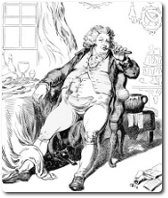Persuasion Contents
Characteristics of the Regency era
Extravagance
 The Regency era spans the reign of the Prince of Wales from 1811 to 1820. It occurred at the latter end of the Georgian period when King George III was declared unfit to rule for reasons of insanity and his son, George IV was appointed as Regent to govern the country. The Prince Regent was notable for his lack of restraint in most areas of life. He was a womaniser who over-ate, over-drank and over-spent. As such he lost the respect of many of his subjects, including Jane Austen herself. In fact, she mocks over-indulgence and vanity of all kinds, while restraint is depicted as a mark of character strength. Nevertheless, his extravagance characterised the period and his patronage of the arts resulted in marked expansion in the areas of:
The Regency era spans the reign of the Prince of Wales from 1811 to 1820. It occurred at the latter end of the Georgian period when King George III was declared unfit to rule for reasons of insanity and his son, George IV was appointed as Regent to govern the country. The Prince Regent was notable for his lack of restraint in most areas of life. He was a womaniser who over-ate, over-drank and over-spent. As such he lost the respect of many of his subjects, including Jane Austen herself. In fact, she mocks over-indulgence and vanity of all kinds, while restraint is depicted as a mark of character strength. Nevertheless, his extravagance characterised the period and his patronage of the arts resulted in marked expansion in the areas of:
- Architecture (typified by the elegant designs of architect John Nash)
- Literature (typified by work of Romantic writers Byron, Shelley and Keats)
- Music (typified by the works of Beethoven, Schubert and Liszt).
The character of Sir Walter in Persuasion could be interpreted as a parody of the Prince Regent.
A widening gap between rich and poor
While the upper classes in the Regency era were enjoying an opulent lifestyle, the lower classes experienced a grinding poverty. The Prince Regent made little effort to relieve the situation and his lavish lifestyle caused a growing resentment. The gap between rich and poor was exacerbated by:
- A sudden increase in the population and increasing overcrowding in the cities, which led to squalid housing conditions. This gave rise to city slums (colloquially known as rookeries). They were associated with prostitution, drunkenness and crime in general
- Inflated food prices, due to Napoleon's blockade of exports to Britain, as well as high wheat prices resulting from the Corn Law of 1815
- Technological advances in the textile industry which eventually wiped out spinning as a cottage industry - hence the Luddite Riots (1811-1816) in which English craftsmen protested about the negative impact of technological advances on employment in the weaving industry.
Recently Viewed
-
Persuasion » Characteristics of the Regency era
now -
A-Z: General definitions » Pantheist
just now -
A-Z: General definitions » Faith
just now -
Quatrains
just now
Scan and go

Scan on your mobile for direct link.